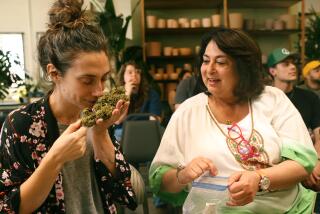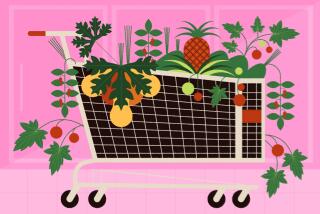Seeds: a starter set for epicures
WE all have our Marthas -- part brand, part person, entrepreneurs who realized our aspirations before we knew we had them, then made their fortunes teaching us how to do it too. My own Martha isnât a statuesque New Englander but a short, bossy lady named Renee Shepherd. She lives up a hill near Santa Cruz, where she keeps an expansive vegetable garden, a staff of people to help tend it and a catalog of largely idiot-proof seeds for sale to help us propagate many of the same plants.
Like all Marthas, Shepherd is a populist. When she puts her name on a pack of seeds, itâs a sign that just about anyone with a decently tilled bed of soil, a hose and the will to weed can grow them. I turned back to them this year after failing with fancier stock last summer.
One thing Shepherdâs seeds are not good for is snob value. On seeing about 20 packets laid out on my kitchen counter recently, a garden designer friend lifted one idly, toyed with it briefly and remarked, âThese are perfect for kids.â
Ouch! Iâm sure thatâs true. However, I had always thought Reneeâs Garden seeds were aimed not so much at kids but my peculiar early 21st century gardening demographic: the dining-room horticulturist.
I cannot be the only one who in the last 25 years has become so accustomed to eating exotic vegetables through farmers markets and restaurants that I expect to find blue potatoes and striped beets wherever I shop.
But during all those years of fabulous eating, I lived in apartments and kept little more than a window box with kitchen herbs. I learned about rapini from behind a menu, not a trowel. As a relatively novice gardener, I have the dangerous combination of high tastes and low skills.
Germ of an idea
Shepherd not only anticipated the likes of me as a customer, she has set up a succession of companies to educate me. I sought her out recently in Santa Cruz to find out how she did it.
She donned a dainty garden hat and offered me one too, as she began a brisk tour of the grounds. Gardening has become so fancy these days, the narration was dominated by thanks for people who helped her along the way -- a local author, her garden manager, a botanical artist, a friendly rival -- as if she were doling out thanks at an Oscars ceremony. (Iâve dropped all their names. But, for the record, she does not hog all the credit.)
It all started, she said, with a soccer game. She was working toward a graduate degree in history at UC Santa Cruz in the 1970s, when she became a host for a regular soccer game staged by a clutch of athletic academics. The husband of a sociology grad student turned out to be a seed salesman for a Dutch firm. âHe took a look at my garden one day and said, âYou have a nice garden but I donât think you have anything good.â â Shepherd had been using the typical American catalog seeds in which the No. 1 virtue was size. The Dutchman told her, âOur varieties are bred for flavor.â
Shepherd began seeking out better seeds: spicier basil, steakier tomatoes, sweeter lettuces. Her search coincided with a restaurant renaissance in the Bay Area led by Chez Panisse. When she published the catalog for her first company, Shepherdâs Garden Seeds, in 1985, she was in the vanguard of the California restaurant boom. Butterhead lettuces, arugula, hot mustards such as mizuna, Dutch Brussels sprouts, Japanese broccoli and baby everything were hot new foods, and Shepherd was a key grower and seeds-woman.
The buzzword was variety. Shepherd began mixing three types of seeds in one pack, offering gardeners not just a sudden shot of choice and color in their beds, but the value of three packs of seeds for the price of one. âI was also one of the first to put recipes on catalogs,â she said. âMy logic was: If I convince you to grow radicchio, I better teach you how to use it.â These catalog recipes led to two cookbooks.
Very Martha.
The company was such a success that in 1988 it was sold to a large mail-order flower and bulb company. Shepherd managed it for a while, but by 1996 she had parted ways with Shepherdâs Garden Seeds and started a new company. Luckily, she still had an unmerchandized half of her name: Renee. The new company became Reneeâs Garden.
But this time, the result no longer was cutting edge. Gourmet gardening in California had moved on since the mid-1980s. Mere flavor was old hat. Ease of growing was not an issue. Extreme skill was presumed. The new currency was rarity of a (preferably endangered) variety. Heirloomism ruled. Acceptable provenances included seeds retrieved from behind the Iron Curtain or discovered in the loft of an Amish barn.
By contrast, as Shepherd launched her second company, she was still teaching amateurs and trading at the twee end of big-time horticulture. This time she was not selling through co-ops but through leading garden centers, including Orchard Supply Hardware and Rogerâs Gardens in Newport Beach. She listed some heirloom vegetables, but her emphasis remained on flavor, appearance, ease of growing and disease resistance.
As she leads her tour, she points proudly to a bed in which red and green romaine form a lush, handsome patchwork. Sheâs delighted that they mature at the same time and bring better color and flavor to a Caesar salad than supermarket romaines.
Tried and true
Her snob value tanked, but the resolute populism was a boon for people like me. At least, when I let it be. In the thrall of my heirloomist friends, last summer I did not use her seeds or those of other good suppliers such as Thompson and Morgan, but bought flats of heirloom tomatoes -- Russian Krims and Brandywines.
I blush to recall that I even bragged to my neighbors that it would be unfair for me to enter the block club tomato competition. I would win. Like heck. Shortly into the growing season, I found that not one of the plants was resistant to a common garden fungus called verticillium wilt, and I didnât have the experience with the old varieties to rotate the planting to avoid buildup in the tomato bed. I only managed a late season crop by grabbing a six-pack of Early Girl and Big Boy seedlings at Home Depot.
Last autumn, when planting my winter lettuces, I returned to Reneeâs Garden seeds for cabbage, arugula, mizuna, endive, oak leaf lettuce, beets and rapini. Every plant germinated, and if my dogs were less of a nuisance and I had taken Shepherdâs advice and used a safe snail bait called Sluggo, all would have survived. As it is, the arugula, endive and cabbages thrived.
This year, I returned to Reneeâs Garden seeds precisely because they are idiot-proof and, in the great learning curve of gardening, I remain very much an idiot, if one with well-honed tastes in fancy salads. Her standard tomato variety, Crimson Carmello, is a French type, full of flavor but also bred for disease resistance. With luck, my first crop of tomatoes will not die on the vine this summer.
I also will be trying Krims and Brandywines again (in pots). I long for tender, speckled Bunte Forellenschluss lettuce (from Seed Savers Exchange). But Iâm also planting Reneeâs Garden disease-resistant Carmellos. Shepherdâs insistence that her seeds be easy to grow ensures people like me, advanced eaters but novice horticulturists, a healthy start in the garden.
Reneeâs Garden seeds are available at garden centers and by mail order; go online to www.reneesgarden.com or call (888) 880-7228. Leading suppliers of heirloom seeds include Seed Savers, 3076 N. Winn Road, Decorah, IA 52101, (563) 382-5990, www.seed savers.org; and Seeds of Change, (888) 762-7333, www.seedsofchange.com.






